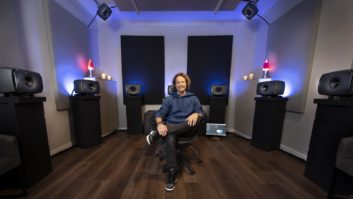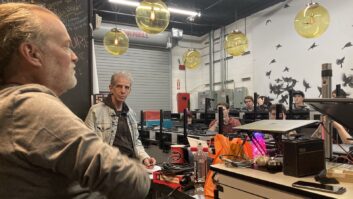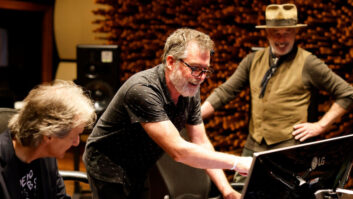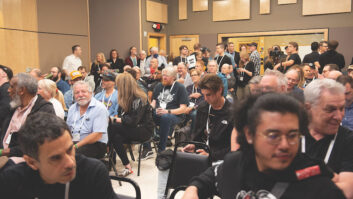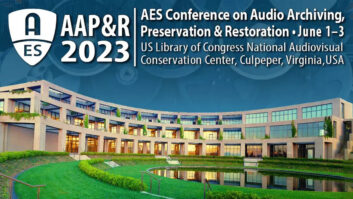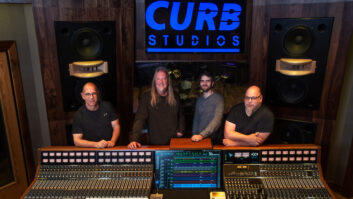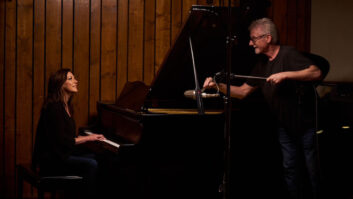Nashville can be deceiving. With all that low-key style and relaxed attitude, people from the rest of the country can sometimes get fooled into thinking that there’s not much going on there. But in reality, people in Music City know how to get a lot of quality music on tape without wasting a moment. Take the session players: Those guys have three tunes learned, played and recorded in the time it takes the L.A. cats to finish their first lattes! (Okay, maybe I’m exaggerating just a little…) Same thing with engineers. Jeff Balding, for example. After a bunch of cell- phone tag, I hooked up with Balding one Saturday morning and found out that he’d spent the previous week working with producer Dann Huff on projects for Keith Urban, Faith Hill, Deana Carter and Wynonna Judd. Yeah, that’s right, all in one week. See what I mean?
Balding, who has received several Grammy nominations, including one for Best Engineered Album on Owsley’s self-titled 1999 release, plies his trade in studios all around the country on all kinds of music; but these days, he makes his home in Nashville. Recently, you’ve heard his work on recordings for Jewel, Trisha Yearwood, Lonestar, Shania Twain and SHeDaisy, among others, as well as on Megadeth’s latest onslaughts. Talk about versatile. Did I mention he’s also president and co-founder of Underground Sound, one of Nashville’s top audio rental, sales and cartage companies?
Obviously, this is a guy at home with the concept of multitasking. Here he shares some tips on how he gets so much accomplished.
Four projects in one week — that’s a lot of bytes.
Well, I have a Fibre Channel drive set up on my Pro Tools HD system, so there’s plenty of reliable storage. It gives me lots of room and flexibility.
Are you doing more tracking or mixing?
Mainly mixing, but I do enjoy tracking. I also enjoy doing an entire record, which is how I work with Dann Huff. He likes to split things up and get two or three rooms going.
So you’ll cover whatever is necessary.
Yeah, it just depends. You want to spend a lot of time on the project to get the best product you can, within the budget. But in country music, that budget is often slimmer than in pop. So, sometimes that means running one hard drive system in the control room, another one out in the lounge for comping and editing and yet another one in a second studio where we can get another set of overdubs going.
It’s not just country. Most budgets are slimmer these days.
There’s a lot going on in the industry right now that’s causing things to be tight: For example, all the pirating of music through downloads from the Internet. But I also think that the introduction of computer-based recording and editing systems has made the thought process change within the industry, as well. With one of these systems, you can basically make a record anywhere, even in your bedroom, which we actually did on the sides I co-produced and engineered on the Owsley record. And this kind of technology has, in some cases, encouraged the belief that a lower budget can be justified. Personally, I think the savings the technology creates should be reinvested to develop a better product. In other words, that translates into spending more time creating the product.
Tell us about your optical-fiber drive system.
It’s a Fibre Channel hard drive setup from Studio Network Solutions. The system allows two or more computers to work on the same song at the same time, on the same drive. I got it mainly because I was tired of having FireWire and SCSI problems and DAE errors when my sessions were packed with a lot of tracks. With the old setup, I also had to do a lot of file management. Now, it’s much easier to put it on one drive and rock! And it’s fast — something like 10 times faster than my other drives. You can easily do 128 tracks on one drive without having the system freak. I don’t see DAE errors anymore, and I can run a backup at the same time on the same computer. I keep the backup running all day at the same time as I’m doing quick, intensive editing, and the system never hangs me up.
SNS put the package together. In appearance, it probably doesn’t look much different than a SCSI setup: It consists of a PCI card and a cable into the drive chassis, which holds four drives — either 36 or 72 Gig — so you can get a lot of desktop space to work on. The big difference is in performance and in the multi-user aspect.
You don’t mix inside of Pro Tools though, do you?
No, I use individual outs, usually 48 into the console, and I feel like I get the best of both worlds. With some of the pop stuff, I may have 80 or 90 tracks to mix; the old Pro Tools systems were 64-voice, and sometimes you had to get real creative with drive management and sharing voices.
But you still have to combine tracks to end up with only 48 out.
Yeah, and I actually prefer having some things combined down. In general, I would rather have two to six tracks of backgrounds than 18 to 25 coming up on the console. Actually, I think if I could get away with a stereo track of drums, I would do that! The less I have to worry about eight hi-hats and four snares, the more I can focus on mixing.
What consoles do you like?
It depends on what I’m mixing. I remixed “Break Me,” the new Jewel single, on the API console at Sound Kitchen, which sounds really good; I like it for tracking as well. I also mixed SHeDaisy there. I thought it would be a good match for them, and it really turned out great. They have a lot of vocal work on the record, and to have a little more openness in the overall console sound really made a big difference. I also like the SSL 9ks and 4ks. There are a couple of 4ks in town that I’ve mixed a lot of records on. In fact, the album mixes on Jewel’s record were done at Emerald’s Studio A on a 4k with a G Series computer.
So, you consider the overall sound of the project and try to choose a console that’s complementary.
Definitely! The right tool for the right job. To me, that’s part of being versatile and adapting to a record’s style. The same with recording: A lot of times, I’ll use a totally different chain to record digitally than I would with analog. I know I need to adapt to the sound of the converters and also to take into account that the sound won’t change after I put it to a digital medium — unlike recording to analog, where it sounds different a week later.
Can you give an example of what you do differently?
For instance, I’m a fan of vintage gear and tube gear. So, if I’m recording to digital and I use a Pultec EQ to put an edge on a vocal, I’ll use the Pultec before the converter to avoid also bringing out the top edge of the converter. Generally, when you add 10 or 12k on a vocal, you’ll get extra out of it before it gets converted to digital. Whereas with analog, it might be better to use the EQ coming back after you’ve got that analog tape compression.
What processing do you prefer to use after your digital conversion?
If I’m recording vocals to digital, I’ll usually compress them after they’re recorded. If I was recording a real rangy vocal to analog, I always felt like I had to compress on the way in, because, with all the hiss, etc., there’s no way to put that wide of a dynamic on analog tape. But then, that one over-the-top vocal blast might get swallowed or distorted from the compression. And if that’s the magic take that the producer wants, I’m up the creek. I’d rather have the note clear and deal with it later in the mix.
Doesn’t that mean you have to record at very conservative levels to avoid any digital distortion?
Not really. I cut a lot of my vocals at -12 or -14 dB, as far as the input level going to the converters. That way, I can pack it on as hard as I want; but when it gets low, it’s not a big deal. The thing that you really have to watch — regarding input level and older gear that may not have much headroom — is overdriving the preamps and compressors, etc., trying to put a hot level to digital.
Say you’re doing drums through a Neve. If you don’t pay attention to whether you’re cutting it at -20 or -12, you may overdrive the preamp so hard that you get compression or distortion out of it (unless you want that sort of effect!) while, on your digital meter, it still looks like your levels are low. I usually cut at -14, -16. You don’t see a lot of VU meters anymore, and that way I’m sure I’m within the headroom of my gear — especially the older gear.
What preamps do you like for vocals?
[Laughs] Actually, I sometimes feel like I’m in the preamp-of-the-month club.
Yes, I’ve heard that you like to change things up a lot on your sessions. What’s this month’s favorite?
For vocals, right now I’m a tube preamp fan, and there are a couple that are sounding good to me. The Telefunken V76m — the one without the roll-off — and the Martec, which I’m using for Faith Hill right now. It has a nice open top.
How about microphones?
Lately, I’m a Neumann fan; the old ones just have a certain air and “core” to their vocal sound. There’s a vintage Neumann U269 that I like a lot. It looks exactly like a U67, but it has a little bit more air on the top.
What’s this month’s drum mic setup?
[Laughs] I use what everybody else does! Right now, I like an Audio-Technica AT25 on the kick, a Shure SM57 on the snare with an AKG 451 on the bottom. For toms, it varies depending on the room, the drummer and, of course, the drums; but it can be anything from AKG 414s to TLM 170s, if you want a nice, warm fat sound.
For overheads, it varies. I use Audio-Technica 4051s sometimes, or [AKG] C 12s. There’s also an old Neumann tube mic I like — a 582. It’s a small-diaphragm mic. You can’t get them too close or they will snap from the sound pressure, but they sound great. They’re also great on acoustic instruments. It’s definitely one of the best-sounding mics nobody’s ever heard of.
Wait a minute. I just remembered you’re an owner of a rental company! That’s why you get to try so many different things all the time! You do R&D for your customers.
[Laughs] Yeah, I’m one of the owners of Underground Sound Inc. In fact, the Neumann 582 was one of the pieces [co-owners] Bill Whittington, Brown Bannister and I found a few years back. They’ve been a big hit in Nashville.
What preamps do you like on drums?
Neve 1081s and 1073s. Although, when I cut at Sound Kitchen’s Big Boy room, I use the API preamps in the console. They sound great, too.
Are you also likely to use your compression after recording the drums?
It depends on the style of record I’m doing — the room, the drum setup — but I usually don’t put the kick and snare down-compressed. I like having whatever options I might need open later. From the tracking standpoint, I’m probably a little more old-school. I like to get a good fat sound down. But I don’t shy away from compression if it’s what the project needs, and the rooms usually get a little compression.
What’s your favorite room mic compressor?
A few that sound great are the UREI 1178 and the Neve 33609s or 33264s. Another compressor that has a cool character for a lot of things is the Empirical Labs Fatso Jr.
You like character in a compressor.
Yeah, a lot of times I look to the compressor to add color. I can really vary in the sound of what I’m looking for — from hi-fi to totally quirky — but I can’t say there are a lot of times I grab for that compressor you can’t hear.
Well, with Pro Tools, you either have to add color on the way in or on the way out.
If you’re talking tonal coloration, I like adding as much as possible on the way in, because when you’re recording, you’re compensating for the sound of whatever you’re recording to and whatever you’re recording through. If those devices have a sound to them — and everything does — you’re trying to find what works in that setup that gets you what you want to hear in the monitors.
And what are the monitors you’d most likely be using?
There are a few I’ll use. Mainly Tannoy SRM 10s with Mastering Lab crossovers. They’re a workhorse that I’ve had for years, and a lot of producers like to listen on them. I’ve got an amp that matches them really well — a Yamaha 2200 that’s been modified by Mastering Lab, as well.
Also, Mackie 824s can be a great reference. You’re not going to get anything muddy by mixing on them. I still listen to [Yamaha] NS-10s; there’s stuff that you hear on them that you don’t catch on the others. And I mix a lot at Emerald where I like the Hidley rooms and I use the big monitors.
Are you originally from the South?
[Laughs] No. I’m from a small town in Illinois; I came to Nashville to go to Belmont University. I’d been heading into electrical engineering and started thinking, “I don’t want to do this.” So, what did I want to do? Like everybody else, I’d played guitar in rock bands through high school, so the music business sounded like the obvious choice. I wanted to make records. I really didn’t think about the possible downfalls on the income side; I just wanted to do it. I think a lot of people head into engineering thinking they’re the next hot thing. But when they get into the studio and see what’s actually involved — the hard work, the long hours and the “no problem” attitude required — they go, “On second thought, this really isn’t what I want!” But I loved it. I just lived and breathed it.
I was fortunate enough to have a roommate at Belmont who was a senior, Steve Fralick. He was studying recording engineering as well, and he took me under his wing. My last year in college, I took a job as chief engineer at a small Christian studio in Brentwood, Tennessee. I met Keith Thomas there and started working with him, and while I worked there, I also recorded a band named Whiteheart, the band that Dann and David Huff were in back then.
I guess my last question for the day is what do you do in your spare time?
What spare time? [Laughs] Well, I’m married and I’ve got two kids and what little spare time there is I try to spend with the family — watching the kids’ sports and doing outdoor stuff. And something else: For a few years now, I always put aside the first couple hours of the day for me. That usually involves going to work out. I owe my good friend Dave Mustaine [of Megadeth] for getting me into working out. I try to keep that part of my life together because sitting in a studio all day, you can get pretty out of shape. I go to the gym, do the routine and have a healthy breakfast. It’s made a real difference in how I feel in general and also in how I feel at the studio.
Maureen Droney is Mix’s Los Angeles editor.
SELECTED CREDITS
Bryan White:How Lucky I Am (1999)
Chely Wright:Never Love You Enough (2001)
Clay Davidson:Unconditional (2000)
Collin Raye:Tracks (2000)
Faith Hill:Breathe (1999)
Jewel:This Way (2001)
Lee Ann Womack:I Hope You Dance (2000)
Lila McCann:Something In the Air (1999)
Lonestar:I’m Already There (2001), Lonely Grill (1999)
Megadeth:Risk (1999)
Reba McEntire:So Good Together (1999)
Self:Breakfast With Girls (1999)
Shania Twain:Come on Over Australian CD (1999)
SHeDaisy:Whole Shebang (1999)
Trace Adkins:Chrome (2001)
Trisha Yearwood:Real Live Woman (2000), Where Your Road Leads (1998)
Wynonna Judd:New Day Dawning (2000)
